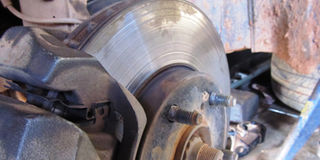The evolution of brake discs, drums

A used brake disc. Disc brakes are generally considered superior to drum brakes.
What you need to know:
Brake discs dissipate heat better (brakes work by converting motion energy to heat energy). Under severe usage, such as repeated hard stops or riding the brakes down a long incline, disc brakes take longer to lose effectiveness. Disc brakes also perform better in wet weather, because centrifugal force tends to fling water off the brake disc and keep it dry, whereas drum brakes will collect some water on the inside surface where the brake shoes contact the drums.
Brake technology, just like many other car technologies, has come a long way in recent years. If you did drive in the late 1980’s you would have a crystal clear idea of the exponential change where brakes are now more than adequate in their most basic state. The introduction of features like ABS (Anti-Lock Braking System) as standard on virtually all cars of today, has all contributed to the reduced stopping distances and generally having safer cars. One of the first steps taken to improve braking came at a time when manufacturers, on a widespread scale, switched from drum to disc brakes. Safer cars
The introduction of components like carbon-fibre, sintered metal and lightweight steel, along with the adoption of ABS (Anti Lock Braking System), has all contributed to the reduced stopping distances and generally safer cars. One of the first steps taken to improve braking came in the early 1970s when manufacturers, on a widespread scale, switched from drum to disc brakes.
Since the majority of a car’s stopping power is contained in the front wheels, more often than not, the front brakes were upgraded to disc and the rear played cool with the drums. And even up to today you can see that Corolla having this setup.
Nonetheless many manufacturers have adopted four-wheel disc brakes on their high-end and performance models as well as their low-line economy cars. Before you can appreciate the difference between drum and disc brakes, you have to understand the common principles that both systems use when stopping a car, that is, friction and heat. By applying resistance, or friction, to a turning wheel, a car’s brakes cause the wheel to slow down and eventually stop, creating heat as a by-product.
The rate at which a wheel can be slowed is governed by a number factors including car weight, braking force and total braking surface area. It also depends heavily on how well a brake system converts wheel movement into heat (by way of friction) and, subsequently, how quickly this heat is removed from the brake components. This is where the difference between drum brakes and disc brakes gets very conspicuous.
Remember that the principle of braking involves turning kinetic energy (wheel movement) into thermal energy (heat). For this reason, drum brakes can only operate as long as they can absorb the heat generated by slowing a car’s wheels. Once the brake components themselves become saturated with heat, they lose the ability to halt a car, which can be somewhat disconcerting to the driver.
Advantages and disadvantages
But unlike drum brakes, which allow heat to build up inside the drum during heavy braking, the rotor used in disc brakes is fully exposed to outside air. This exposure works to constantly cool the rotor, greatly reducing its tendency to overheat or cause fading. Not surprisingly, it was under racing circumstances that the weaknesses of drum brakes and the strengths of disc brakes were first illustrated.
Disc brakes cool better, because air can circulate across the friction surface easily. Ventilated rotors have two friction surfaces separated by a series of fins. These allow air inside the rotor between the friction surfaces for even better cooling. Another advantage of discs is that debris is thrown off the spinning disc, unlike a drum that traps the debris. Some discs come with cross-drilled holes that dissipate heat quickly and brake dust to maximise braking ability.
The biggest disadvantage of disc brakes is that they are exposed to dirt. Dirt and dust between the rotor and pads can wear the disc quickly. Also they are not as effective when used for parking as the drum brakes.
Drum brakes allow simple incorporation of a parking brake and as such are commonly fitted as the parking (and emergency) brake even when the rear wheels use disc brakes as the main brakes.
In today’s auto playing field, it’s not unusual to find four-wheel disc brakes as standard equipment on medium-priced, non performance-oriented models.
A significant number of new cars, nevertheless, continue to utilise a front-disc-rear-drum brake setup. The thing is today’s disc/drum setups are completely adequate for the majority of new cars keeping in mind that you won’t use your Toyota Raum to go rally race Ronald against Ssebuguzi.
Additionally it’s cheaper as a drum brake also can serve as a parking brake. So you’re essentially getting two for one. Combined with the fact that between 60 and 90 perm cent of a car’s stopping power comes from the front wheels, it’s clear that a well-designed, modern drum brake is all that’s required for most rear wheel brake duty.
=======================================
About the brakes
Disc brakes sometimes spelled as “disk” brakes, use a flat, disk-shaped metal rotor that spins with the wheel. When the brakes are applied, a caliper squeezes the brake pads against the disc (just as you would stop a spinning disc by squeezing it between your fingers), slowing the wheel.
Drums brakes use a wide cylinder that is open at the back, similar in apprearance to, well, a drum. When the driver steps on the brake pedal, curved shoes located inside the drum are pushed outwards, rubbing against the inside of the drum and slowing the wheel.
cars.about.com




